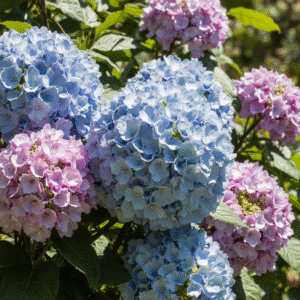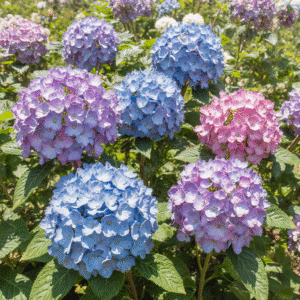Hydrangeas: The Secret to a Blooming Backyard
If You’ve Been Struggling to Make Your Garden Stand Out, You’re Not Alone
Have you ever walked past a beautifully blooming garden and felt that twinge of envy? The vibrant colors, the soft petals dancing with the breeze—it all feels like a page from a magazine. But then you look at your own yard… and it’s just green. Maybe patchy. Maybe dry. Maybe you’ve tried to plant flowers before, but nothing took root the way you hoped. It’s frustrating—and honestly, it makes you want to give up on gardening altogether.
Here’s the thing: the problem isn’t you. Most people don’t realize that creating a stunning, low-maintenance garden doesn’t require a degree in botany. It just takes one plant that does all the heavy lifting—and that plant is the hydrangea.

The Hydrangea Effect: Transforming Your Garden Overnight
Now imagine this instead: you step outside in the morning and are greeted by full, bushy hydrangeas in shades of pink, blue, purple, and white. The neighbors slow down when walking by just to admire them. You get compliments from friends, strangers—even the mailman. Your garden becomes a peaceful retreat, a colorful corner that feels like your own secret paradise.
Hydrangeas aren’t just pretty; they’re powerful. They fill up space with minimal effort, bloom for months, and adjust their colors depending on your soil. Yes, that’s right—you can control the color of the blooms just by tweaking your soil’s pH. Talk about magic in your backyard!
Why Hydrangeas Work for Anyone (Even If You’ve Killed Plants Before)
One of the biggest perks of hydrangeas is how low maintenance they are. These plants thrive in partial shade, which makes them perfect even for gardens that don’t get full sunlight all day. They’re also drought-tolerant once established and can survive a bit of neglect without throwing in the towel.
And unlike other showy flowers that only bloom for a week or two, hydrangeas keep giving. Their bloom season can last from spring through late summer—and in some climates, they hold their dried flowers into fall, creating a four-season visual appeal.
What’s more: you don’t need to be an expert gardener. Plant them in well-draining soil, water them consistently in the early stages, and add some compost once in a while. That’s it. No complicated rituals or daily maintenance.

Common Hydrangea Mistakes (and How to Avoid Them)
Now, let’s pause here. You’re probably thinking: “Sounds too good to be true. What’s the catch?”
The truth is, most people don’t get the full magic of hydrangeas because they make a few classic mistakes:
Wrong pruning timing – Different hydrangea types bloom on old wood or new wood. If you cut at the wrong time, you might not see flowers for a year.
Ignoring soil pH – Want blue flowers? Your soil needs to be more acidic. Prefer pink? You’ll need a more alkaline base.
Overwatering or underwatering – Young hydrangeas love consistent moisture, but drowning the roots can kill them just as fast.
Once you understand these few rules, you’re golden.
Types of Hydrangeas: Choosing the Right One for Your Garden
There are several types of hydrangeas, and each brings something different to the table:
Bigleaf Hydrangeas (Hydrangea macrophylla) – Known for their color-shifting abilities.
Panicle Hydrangeas (Hydrangea paniculata) – Taller, cone-shaped blooms, perfect for hedges.
Smooth Hydrangeas (Hydrangea arborescens) – Hardy and reliable in all climates.
Oakleaf Hydrangeas (Hydrangea quercifolia) – Distinctive foliage and great fall color.
Take a moment to walk through your space and think: Do you want height? Do you want volume? Do you want bold color? There’s a hydrangea for every vision.
From Barren Yard to Garden Showpiece: Your Next Steps
So, how do you actually start? Here’s the simplest plan:
Pick your spot – Choose an area with morning sun and afternoon shade.
Prep your soil – Loosen it up, check the pH if you’re chasing color, and mix in compost.
Plant and water – Dig a hole twice the size of the root ball, water deeply, and mulch around the base.
Feed lightly – Use a slow-release fertilizer suited for flowering shrubs.
In just a few weeks, you’ll see your hydrangeas settling in—and within a season, they’ll take over with beauty you didn’t think was possible.
Hydrangeas and Mental Wellness: More Than Just Beauty
Studies have shown that spending time around greenery and flowers can boost mood, reduce stress, and even improve focus. Hydrangeas, with their full, rounded shape and soothing colors, provide an extra sense of calm and happiness.
Adding them to your garden isn’t just an aesthetic choice—it’s an investment in your well-being. Your backyard becomes your sanctuary, a space where you can unwind, reflect, and enjoy a little piece of peace every single day.
What Are You Waiting For? Your Dream Garden Starts Now
Here’s the truth: a blooming, envy-worthy garden doesn’t require tons of time, money, or expertise. It just requires the right plant to set the stage—and hydrangeas are that plant.
Whether you’re looking to enhance curb appeal, create a calming space for your morning coffee, or finally enjoy the outdoor space you’ve always dreamed of, now is the perfect time to plant hydrangeas. The best gardens don’t happen by accident—they start with one smart choice.
Ready to take the first step? Start by exploring hydrangea varieties at your local nursery or garden center.
And if you’d like more tips on gardening for beauty, wellness, and ease, check out our other articles in the Home & Garden section right here.
Want more gardening hacks and wellness tips delivered weekly? Stay tuned—because we’ve got a lot more coming your way.
The Opportunity Is Here – For a Limited Time Only!
Get access to Ideas4Landscaping and see real results.
Take Advantage Now →